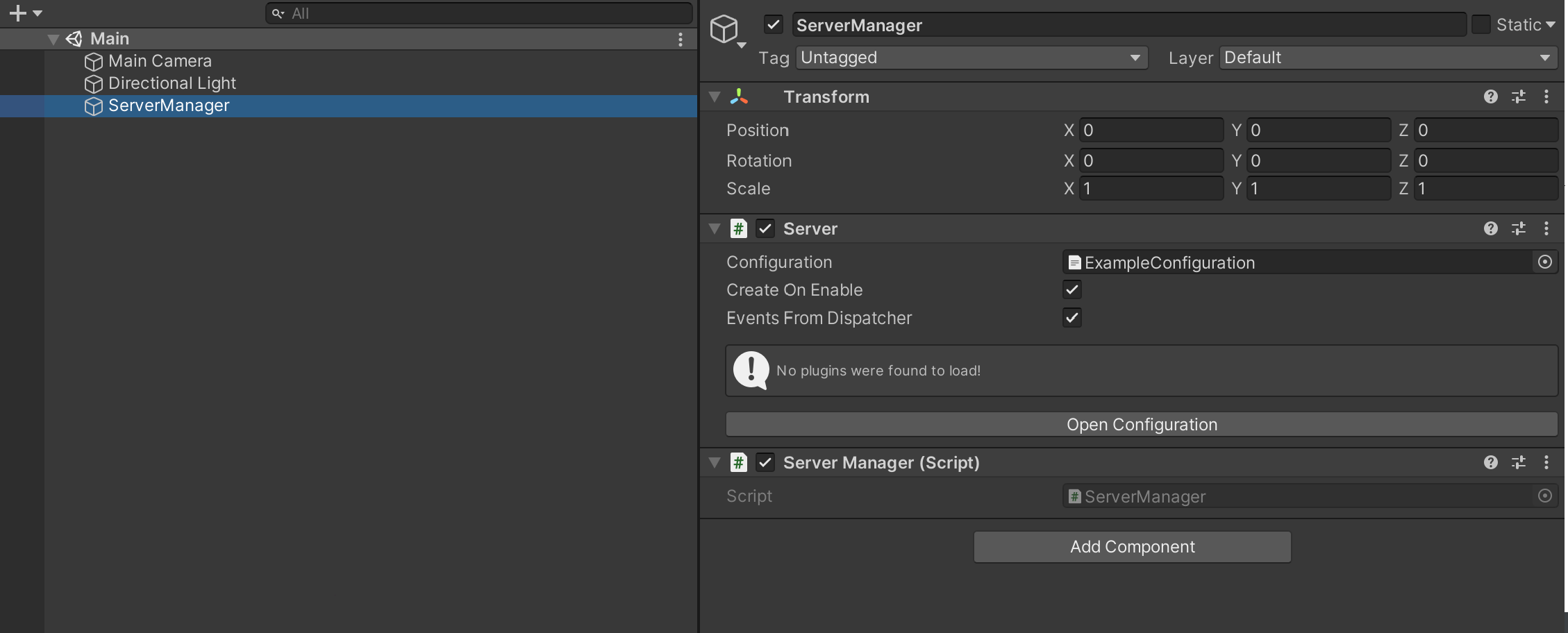# Server Basics and Login System
On the server we need to:
- Create a GameObject called ServerManager in the Main scene.
- Create a ServerManager script in Scripts.
- Add a XmlUnityServer component to the ServerManager gameobject.
- In the Configuration field of the XmlUnityServer link the ExampleConfiguration in the Darkrift folder.
- Add the ServerManager script to the ServerManager gameobject.
In the ServerManager script add the following code:
public static ServerManager Instance;
private XmlUnityServer xmlServer;
private DarkRiftServer server;
void Awake()
{
if (Instance != null)
{
Destroy(gameObject);
return;
}
Instance = this;
DontDestroyOnLoad(this);
}
pretty similar to the ConnectionManager of the client. The ServerManager is a singleton as well.
(and you will need the following directives at the top of the file)
using System.Collections.Generic;
using DarkRift;
using DarkRift.Server;
using DarkRift.Server.Unity;
using UnityEngine;
Your scene should look now like this:

As a next step will add functionality to the ServerManager to receive messages from clients. To do that we have to subscribe to events of the Darkrift Server.
void Start()
{
xmlServer = GetComponent<XmlUnityServer>();
server = xmlServer.Server;
server.ClientManager.ClientConnected += OnClientConnected;
server.ClientManager.ClientDisconnected += OnClientDisconnected;
}
void OnDestroy()
{
server.ClientManager.ClientConnected -= OnClientConnected;
server.ClientManager.ClientDisconnected -= OnClientDisconnected;
}
private void OnClientDisconnected(object sender, ClientDisconnectedEventArgs e)
{
e.Client.MessageReceived -= OnMessage;
}
private void OnClientConnected(object sender, ClientConnectedEventArgs e)
{
e.Client.MessageReceived += OnMessage;
}
private void OnMessage(object sender, MessageReceivedEventArgs e)
{
}
The code first subscribes to the ClientConnected and ClientDisconnected events. These events get called when clients connect and disconnect. We also subscribe to the IClient.MessageRecieved event when a client connects so that we receive messages from all clients in OnMessage(). This lets us process our LoginRequests from the clients by adding code in the OnMessage function:
private void OnMessage(object sender, MessageReceivedEventArgs e)
{
IClient client = (IClient) sender;
using (Message message = e.GetMessage())
{
switch ((Tags) message.Tag)
{
case Tags.LoginRequest:
OnclientLogin(client, message.Deserialize<LoginRequestData>());
break;
}
}
}
This code just gets the Client which sent the message and the message itself from the MessageReceived event and then uses a switch to run a function depending on the Tag of the message, it should be quite self-explanatory.
We also have to create the function that gets called:
private void OnclientLogin(IClient client, LoginRequestData data)
{
// Check if player is already logged in (name already chosen in our case) and if not create a new object to represent a logged in client.
}
WARNING
Usually you would create a LoginManager on the server which talks to a backend to verify the login request and then you would generate a session token, but we will keep it simple here and just check that no duplicate users are logged in(Each player has a unique name).
Now we have to create an object to represent a logged in player, so create a new "ClientConnection" script in the Scripts folder. And change its code to this:
using DarkRift;
using DarkRift.Server;
public class ClientConnection
{
public string Name { get; }
public IClient Client { get; }
public ClientConnection(IClient client , LoginRequestData data)
{
Client = client;
Name = data.Name;
ServerManager.Instance.Players.Add(client.ID, this);
ServerManager.Instance.PlayersByName.Add(Name, this);
}
And add Dictionaries in the ServerManager to store the authenticated players:
public Dictionary<ushort, ClientConnection> Players = new Dictionary<ushort, ClientConnection>();
public Dictionary<string, ClientConnection> PlayersByName = new Dictionary<string, ClientConnection>();
Now we can also fill in the OnClientLogin function in the ServerManager:
private void OnclientLogin(IClient client, LoginRequestData data)
{
if (PlayersByName.ContainsKey(data.Name))
{
using (Message message = Message.CreateEmpty((ushort)Tags.LoginRequestDenied))
{
client.SendMessage(message, SendMode.Reliable);
}
return;
}
// In the future the ClientConnection will handle its messages
client.MessageReceived -= OnMessage;
new ClientConnection(client, data);
}
The function will first check if the name is already in use and if it is, it sends back a LoginRequestDenied data. If the name hasn't been used yet we create a new ClientConnection and unsubscribe from client.MessageRecieved, because in the future we can use the ClientConnection to handle messages from that client.
Finally we have to send an LoginRequestAccepted message when the client has logged in successfully. This message should also contain additional information. In our case we want to let the client know his personal id on the server and information about the lobby and game rooms. (We will create a room system in the next section)
So open the NetworkingData script in the Client Project (Remember the junction only works in 1 direction) and add:
public struct LoginInfoData : IDarkRiftSerializable
{
public ushort Id;
public LobbyInfoData Data;
public LoginInfoData(ushort id, LobbyInfoData data)
{
Id = id;
Data = data;
}
public void Deserialize(DeserializeEvent e)
{
Id = e.Reader.ReadUInt16();
Data = e.Reader.ReadSerializable<LobbyInfoData>();
}
public void Serialize(SerializeEvent e)
{
e.Writer.Write(Id);
e.Writer.Write(Data);
}
}
public struct LobbyInfoData : IDarkRiftSerializable
{
public void Deserialize(DeserializeEvent e)
{
}
public void Serialize(SerializeEvent e)
{
}
}
LoginInfoData is the information that the client will receive after logging in and it includes LobbyInfoData which contains information about the lobby (currently empty).
now let's send that message at the end of the constructor of the ClientConnection script, it should look like this:
public ClientConnection(IClient client , LoginRequestData data)
{
Client = client;
Name = data.Name;
ServerManager.Instance.Players.Add(client.ID, this);
ServerManager.Instance.PlayersByName.Add(Name, this);
using (Message m = Message.Create((ushort)Tags.LoginRequestAccepted, new LoginInfoData(client.ID, new LobbyInfoData(RoomManager.Instance.GetRoomDataList()))))
{
client.SendMessage(m, SendMode.Reliable);
}
}
The scripts should now look like this:
- ServerManager (opens new window)
- ClientConnection (opens new window)
- NetworkingData (opens new window)
In the next section we will create a room system and add information about rooms to the LobbyInfoData.